George Cole - The Father of KPBX
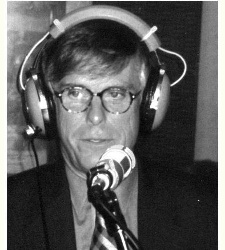 KPBX was the brain child of George Cole,
doing business as the Spokane Public Broadcasting Association,
who wanted start an educational station in Spokane in the early
1970's. The station was originally located in the basement of
the Cole's home on the South Hill at 24 West 27th Avenue.
KPBX was the brain child of George Cole,
doing business as the Spokane Public Broadcasting Association,
who wanted start an educational station in Spokane in the early
1970's. The station was originally located in the basement of
the Cole's home on the South Hill at 24 West 27th Avenue.
(Origin of photo unknown)
The precise date that KPBX-FM commenced broadcasting is not known. However from the license records, we know the following concerning KPBX.
- The first construction permit was issued on 30 January 1971. The listed transmitter was a 10-watt Gates BFE-10A and the antenna a Gates FM-11 halo-shaped antenna, which was mounted 60 feet above the ground on a power pole.
- The FCC assigned the call letters KPBX-FM on 22 February 1972.
- The FCC issued the station's first license on 17 July 1972.
- The station was a non-commercial educational station.
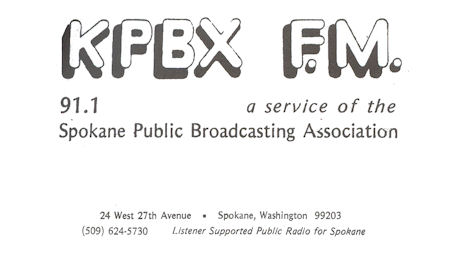
(National Archives)
COMMENTS BY BILL HARMS
I visited the station numerous times when it was at the Cole's home and tried announcing a couple of times sitting side-saddle to other more experienced announcers. That was my only time I ever tried on-the-air broadcasting. I remember that when you pulled up in the alley behind the house, the halo-shaped antenna on top of the power pole was clearly visible. As you entered the basement from the back side of the house, the 10-watt Gates FM transmitter appeared immediately on your right. In the opposite corner of the basement was a little covey which contained the broadcast equipment, details of which you can see in Dean Martin's account below. One thing that was distinctive was the egg-carton acoustical panels on the wall. I am not sure how effective they were, but some people thought they did the job. I remember sitting side saddle to Dean Martin (see below) and playing a few records. I managed to pick up KPBX's feeble 10-watt signal in the Spokane Valley about 8 miles away and requested the song "Dead Skunk In the Middle of the Road.",which Dean gladly played it for me.
(National Archives)
DEAN MARTIN COMMENTS ABOUT HIS TIME AT KPBX
"I have a connection to Spokane radio history because I was part of the group of volunteers that put the original KPBX on the air. That was back when the station transmitted with 10 watts from the basement of George Cole's house on the South Hill. I really loved radio back then and I look back at that time with great fondness. I read about George's efforts to start the first public radio station in Spokane and called him. George, who was a newscaster for KREM, was pretty charismatic and sold me on his dream to build the station. George managed to raise enough money to get the station licensed. KHQ cleaned out their basement and donated a bunch of 40's era audio equipment and a old FM exciter that was used as the transmitter. Washington Water Power planted one of their biggest wooden power poles in the backyard for the antenna.
"All George needed was a staff and that's where the volunteers came in. What a motley crew we were! A lot of high school kids like me, with a few pro's (or semi-pro's) tossed in to teach us the ropes. We'd meet every week in George's dining room to study for our FCC third-class radio operators license. George got one of the engineers from KREM, Isador "Copey" Copell, to teach the weekly classes. Copey was also the stations CE.
"It was a long time ago and I forget exactly when we went on the air, but I'm pretty sure it was in 1972. I am certain of one thing, I have the dubious distiction of earning the station it's first FCC warning. The station had only been on the air for a few days and it was during the first hour of my very first air shift. I was playing a classical album and misunderstood the bottom of the hour ID regulation. Even though there were breaks in the music, I played the entire side of the album before making the station ID, which was about 10 minutes late. The FCC monitoring station out at Four Lakes caught the gaff and sent the warning by mail. George showed it to me the following week. He was pretty cool about it. Most of his air staff was pretty green, so mistakes were going to happen. Just learn from it and move on.
"Most of us pulled a 4 hour shift once a week with the reward of being able to program one hour with whatever we wanted. I had Wednesdays from 5pm (sign on) to 9pm and the 8 to 9 hour was mine. In retrospect, one of the things I liked about George was his subtle way of shaping our shows. I knew very little about jazz, but he suggested that I might enjoy it and offered some suggestions. Not long after that my hour was devoted to jazz and it is still one of my favorite kinds of music.
"Back then KPBX was George's station, but even he was a volunteer and he had to earn a living. His career took him out of Spokane in 1974 and he turned management of the station over to Dave Schoengold. I liked Dave. He was the first "New Yorker" I ever spent time with. He took KPBX in another direction, which eventually lead the station to where it is today."
(The four photos below and the accompanying text courtesy of Dean Martin, Spokane, Washington.) (Click on the images for an enlarged view.)
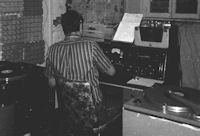
I'm pretty sure this is Tom Brown, taken on a Sunday afternoon when he was pre-recording bits for his show. George would let us come in on Sundays before sign-on to practice or do production work.
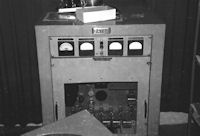
The "mighty" 10 watt transmitter! I built an antenna so I could receive the station where I lived in the valley.
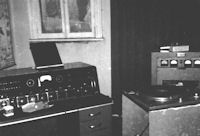
This was taken during set-up of the studio. Without knowing the context you'd think the picture was taken 30 years earlier.
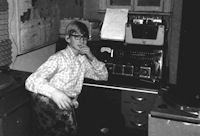
That's me. Note the dark spot on my ear. We didn't have headphones, we had a pair of really uncomfortable earphones, sort of like those used with a Dictaphone. After a few months on the air most of us started using our own headphones.
If you have any memories or experiences about KPBX, please
contact me at ![]()
Compiled and editted by Bill Harms - 7 May 2009

